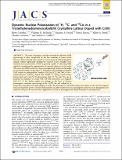| dc.contributor.author | Luchinat, Claudio | |
| dc.contributor.author | Corzilius, Bjorn | |
| dc.contributor.author | Michaelis, Vladimir K. | |
| dc.contributor.author | Penzel, Susanne | |
| dc.contributor.author | Ravera, Enrico | |
| dc.contributor.author | Griffin, Robert Guy | |
| dc.contributor.author | Smith, Albert A. | |
| dc.date.accessioned | 2017-07-06T17:34:23Z | |
| dc.date.available | 2017-07-06T17:34:23Z | |
| dc.date.issued | 2014-07 | |
| dc.date.submitted | 2014-05 | |
| dc.identifier.issn | 0002-7863 | |
| dc.identifier.issn | 1520-5126 | |
| dc.identifier.uri | http://hdl.handle.net/1721.1/110494 | |
| dc.description.abstract | The study of inorganic crystalline materials by solid-state NMR spectroscopy is often complicated by the low sensitivity of heavy nuclei. However, these materials often contain or can be prepared with paramagnetic dopants without significantly affecting the structure of the crystalline host. Dynamic nuclear polarization (DNP) is generally capable of enhancing NMR signals by transferring the magnetization of unpaired electrons to the nuclei. Therefore, the NMR sensitivity in these paramagnetically doped crystals might be increased by DNP. In this paper we demonstrate the possibility of efficient DNP transfer in polycrystalline samples of [Co(en)[subscript 3]Cl[subscript 3]][subscript 2]·NaCl·6H[subscript 2]O (en = ethylenediamine, C[subscript 2]H[subscript 8]N[subscript 2]) doped with Cr(III) in varying concentrations between 0.1 and 3 mol %. We demonstrate that [superscript 1]H, [superscript 13]C, and [superscript 59]Co can be polarized by irradiation of Cr(III) with 140 GHz microwaves at a magnetic field of 5 T. We further explain our findings on the basis of electron paramagnetic resonance spectroscopy of the Cr(III) site and analysis of its temperature-dependent zero-field splitting, as well as the dependence of the DNP enhancement factor on the external magnetic field and microwave power. This first demonstration of DNP transfer from one paramagnetic metal ion to its diamagnetic host metal ion will pave the way for future applications of DNP in paramagnetically doped materials or metalloproteins. | en_US |
| dc.description.sponsorship | National Institutes of Health (U.S.) (EB00280) | en_US |
| dc.description.sponsorship | National Institutes of Health (U.S.) (EB002026) | en_US |
| dc.description.sponsorship | German Science Foundation (DFG Research Fellowship CO 802/1-1) | en_US |
| dc.description.sponsorship | Natural Sciences and Engineering Research Council of Canada (Banting Postdoctoral Fellowship) | en_US |
| dc.description.sponsorship | European Molecular Biology Organization (ASTF-491/2013) | en_US |
| dc.language.iso | en_US | |
| dc.publisher | American Chemical Society (ACS) | en_US |
| dc.relation.isversionof | http://dx.doi.org/10.1021/ja5044374 | en_US |
| dc.rights | Article is made available in accordance with the publisher's policy and may be subject to US copyright law. Please refer to the publisher's site for terms of use. | en_US |
| dc.source | ACS | en_US |
| dc.title | Dynamic Nuclear Polarization of [superscript 1]H, [superscript 13]C, and [superscript 59]Co in a Tris(ethylenediamine)cobalt(III) Crystalline Lattice Doped with Cr(III) | en_US |
| dc.title.alternative | Dynamic Nuclear Polarization of 1H, 13C, and 59Co in a Tris(ethylenediamine)cobalt(III) Crystalline Lattice Doped with Cr(III) | en_US |
| dc.type | Article | en_US |
| dc.identifier.citation | Corzilius, Björn et al. “Dynamic Nuclear Polarization of 1 H, 13 C, and 59 Co in a Tris(ethylenediamine)cobalt(III) Crystalline Lattice Doped with Cr(III).” Journal of the American Chemical Society 136.33 (2014): 11716–11727. © 2014 American Chemical Society | en_US |
| dc.contributor.department | Massachusetts Institute of Technology. Department of Chemistry | en_US |
| dc.contributor.department | Francis Bitter Magnet Laboratory (Massachusetts Institute of Technology) | en_US |
| dc.contributor.mitauthor | Corzilius, Bjorn | |
| dc.contributor.mitauthor | Michaelis, Vladimir K. | |
| dc.contributor.mitauthor | Penzel, Susanne | |
| dc.contributor.mitauthor | Ravera, Enrico | |
| dc.contributor.mitauthor | Smith, Albert Andrew | |
| dc.contributor.mitauthor | Griffin, Robert Guy | |
| dc.relation.journal | Journal of the American Chemical Society | en_US |
| dc.eprint.version | Final published version | en_US |
| dc.type.uri | http://purl.org/eprint/type/JournalArticle | en_US |
| eprint.status | http://purl.org/eprint/status/PeerReviewed | en_US |
| dspace.orderedauthors | Corzilius, Björn; Michaelis, Vladimir K.; Penzel, Susanne A.; Ravera, Enrico; Smith, Albert A.; Luchinat, Claudio; Griffin, Robert G. | en_US |
| dspace.embargo.terms | N | en_US |
| dc.identifier.orcid | https://orcid.org/0000-0002-6708-7660 | |
| dc.identifier.orcid | https://orcid.org/0000-0003-1589-832X | |
| mit.license | PUBLISHER_POLICY | en_US |
